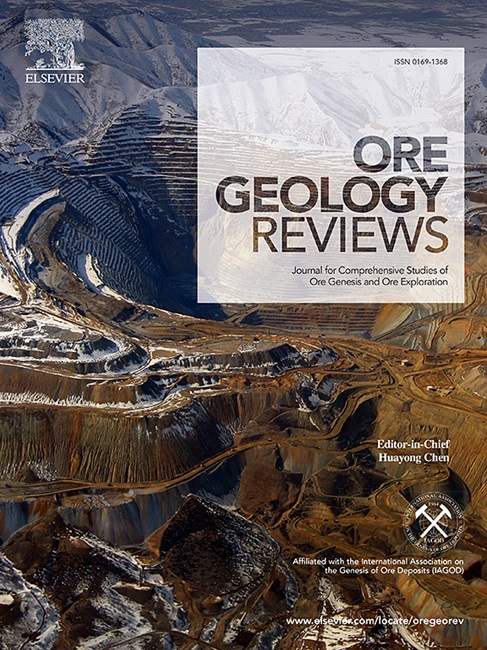Genesis of the Boka vein-type Au deposit, Dongchuan, southwestern China: Insights from rutile U–Pb dating and pyrite chemistry
IF 3.6
2区 地球科学
Q1 GEOLOGY
引用次数: 0
Abstract
The Boka gold deposit, located in the Kangdian metallogenic province of southwestern China, is a newly explored vein-type gold deposit that is distinct from the typical iron oxide-copper–gold (IOCG) deposits in the region. Gold mineralization is primarily hosted in quartz-sulfide veins within alteration zones surrounding diabase, with an estimated reserve of 20 tons and an average grade of 1.6 g/t. Given that gold predominantly occurs as native gold in quartz-pyrite veins, the timing and source of ore-forming materials remain widely debated. To better understand the genesis of the Boka deposit and its relationship to regional tectonic events, this study conducted in situ rutile U–Pb dating and geochemical analysis on hydrothermal rutile and pyrite associated with native gold. The U–Pb dating of rutile yields a lower intercept age of 783 ± 32 Ma, consistent with previously reported pyrite Re-Os ages, thereby providing a precise formation age for the Boka gold deposit. The δ34S values of gold-stage pyrite (4.54 ‰-6.03 ‰), combined with its low Co/Ni ratios (<1), indicate that hydrothermal fluids are primarily derived from magmatic fluids associated with coeval diabase. Gold-enriched strata in the region are interpreted to have formed in a continental-rift setting during the Paleoproterozoic to Mesoproterozoic, providing the primary source of gold. Magmatism of diabase, emplaced in an extensional tectonic setting, acts as a key driver for hydrothermal-fluid circulation and gold remobilization. Based on these findings, we propose that the Boka deposit is a product of subduction-related magmatism during Neoproterozoic, representing a new magmatic–hydrothermal deposit type in the Kangdian region. These insights are expected to advance our understanding of regional metallogenesis and offer valuable guidance for future exploration.

东川博卡脉型金矿床成因:金红石U-Pb测年和黄铁矿化学的启示
博卡金矿床位于中国西南康甸成矿省,是一个不同于该区典型的氧化铁-铜-金(IOCG)型金矿床的脉状金矿床。金矿化主要赋存于辉绿岩周围蚀变带内的石英硫化物脉中,估计储量为20吨,平均品位为1.6 g/t。鉴于金主要以天然金的形式存在于石英-黄铁矿脉中,成矿物质的时间和来源仍然存在广泛的争议。为了更好地了解博卡矿床的成因及其与区域构造事件的关系,本文对与自然金相关的热液金红石和黄铁矿进行了原位金红石U-Pb定年和地球化学分析。金红石的U-Pb测年得到了较低的截距年龄(783±32 Ma),与前人报道的黄铁矿Re-Os年龄一致,从而为博卡金矿床提供了精确的形成年龄。金期黄铁矿的δ34S值(4.54‰~ 6.03‰)与较低的Co/Ni比值(<1)相结合,表明热液主要来源于与辉绿岩相关的岩浆流体。区内富金地层形成于古元古代至中元古代的大陆裂谷环境中,是金的主要来源。辉绿岩岩浆活动处于伸展构造环境中,是热液循环和金矿再成矿的重要驱动因素。据此,我们认为博卡矿床是新元古代俯冲相关岩浆作用的产物,代表了康店地区一种新的岩浆热液矿床类型。这些发现有望促进我们对区域成矿作用的认识,并为今后的勘探提供有价值的指导。
本文章由计算机程序翻译,如有差异,请以英文原文为准。
求助全文
约1分钟内获得全文
求助全文
来源期刊

Ore Geology Reviews
地学-地质学
CiteScore
6.50
自引率
27.30%
发文量
546
审稿时长
22.9 weeks
期刊介绍:
Ore Geology Reviews aims to familiarize all earth scientists with recent advances in a number of interconnected disciplines related to the study of, and search for, ore deposits. The reviews range from brief to longer contributions, but the journal preferentially publishes manuscripts that fill the niche between the commonly shorter journal articles and the comprehensive book coverages, and thus has a special appeal to many authors and readers.
 求助内容:
求助内容: 应助结果提醒方式:
应助结果提醒方式:


